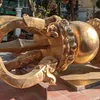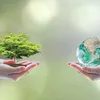Wildlife conservation–how compassion and collaboration can help preserve precious habitats
In our second photo essay from Karnataka Chitrakala Parishath, we showcase more wildlife pictures and conservation insights.
Launched in 2014, PhotoSparks is a weekly feature from YourStory, with photographs that celebrate the spirit of creativity and innovation. In the earlier 735 posts, we featured an art festival, cartoon gallery. world music festival, telecom expo, millets fair, climate change expo, wildlife conference, startup festival, Diwali rangoli, and jazz festival.
In Part I of our photo essay from Karnataka Chitrakala Parishath in Bengaluru, we featured the wildlife exhibition by MN Jayakumar, former Additional Principal Chief Conservator of Forests, and Member Secretary, Zoo Authority of Karnataka.

For over three decades, he has been photographing nature and wildlife, and now champions the cause of conservation and sustainability. He has spent extensive time documenting nature in Africa, Australia, and Latin America as well, and has assisted in the making of a documentary on Ranganathittu bird sanctuary.
Jayakumar also describes some of his favourite photography memories and stories. “There are quite a few of them, particularly those involving interaction between mothers and young ones of various species,” he tells YourStory.
These include the tiger, Asiatic lion, Asiatic elephants, African lions, many bird species, and images captured at dawn and dusk for their pictorial value. Some of the exhibited photographs are priced from Rs 8,000 to Rs 60,000.

This depends on the media on which the images are printed, the size of the images, and the way they are framed. “Printing on imported canvas such as Hahnemuhle Daguerre and using good imported frames would be expensive,” Jayakumar explains.
He has important messages for the audience on the necessity of conservation. “It is absolutely essential to preserve whatever is left of our natural world. All species are inter-related and they have specific roles to play,” he describes.
“There is a very delicate balance between species, and if this balance is disturbed the repercussions are catastrophic,” he cautions.

In this regard, he quotes well-known ornithologist Salim Ali: “Every form of natural life like plants, insects and birds is a vital cog in the machinery which is the natural system of life on this planet. If there is any disturbance in any species of either plant or animal life, its repercussions are felt all the way through the whole kingdom of nature.
“But for the trees, the insects would perish, but for the insects, birds would perish, but for the birds, the trees would perish and following this inexorable law of nature, but for the trees the world would perish.”
In this regard, Jayakumar urges government, society, and the business world to collaborate for preserving wildlife. “In the name of progress and development, many wildlife habitats are getting adversely affected by way of converting these landscapes into urban landscapes and industrial development, thus leading to human-animal conflicts,” he laments.

“The corridors linking various habitats have either become lost or are getting degraded,” he cautions.
He advocates acquisition of private lands lying within the corridors of wildlife movement and adding them to the surrounding wildlife habitats. “This will go a long way in mitigating human-animal conflict and also provide a safe passage for the wild animals,” he adds.
“The corporates can arrange the finances required for such acquisitions under CSR and help the government,” Jayakumar signs off.
Now what have you done today to pause in your busy schedule and harness your creative side for a better world?















MN Jayakumar interacting with students at the exhibition 'Encounters in the Wild, 2.0'
(All photographs of nature and wildlife images were taken by Madanmohan Rao on location at the gallery.)
See also the YourStory pocketbook ‘Proverbs and Quotes for Entrepreneurs: A World of Inspiration for Startups,’ accessible as apps for Apple and Android devices.
Edited by Megha Reddy











